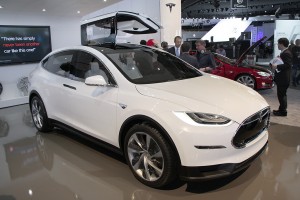
Tesla's Elon Musk tweeted recently that the Model X crossover will be slightly more expensive than the Model S sedan.
Any time Elon Musk starts tweeting, Tesla aficionados scramble to see if there’s news or even hints about what’s to come and in a recent string of tweets, he didn’t disappoint.
Musk, the company’s founder, took to social media to talk about both of the California-based EV maker’s anticipated vehicles: the Model 3 and Model X.
The Model 3, which is slated to be maker’s mass-market entry, is expected to transform Tesla from a money-losing, niche operation into a profitable, high-volume manufacturer, Musk previously laying out a goal of hitting sales of at least 500,000 vehicles annually by decade’s end, or 10 times what he expects in 2016.
Musk suggested the price will be about $35,000 when the production-ready version hits the streets in a couple of years. The Model 3 can’t be brought to market any sooner because it needs the company’s Gigafactory, currently under construction in Nevada, to be churning out low-cost batteries.
Tesla needs scale to drive down battery production costs, which allows the maker to sell the Model 3 for $35,000, he said. When the Model S was first conceived, early this decade, industry analysts estimated Tesla was paying as much as $1,000 a kilowatt-hour for its lithium-ion batteries. With the Gigafactory at full volume, some estimate that could fall to $200 or less. In a vehicle like the Model S P85d, with its 85 kWh of batteries, the plunge in costs could save Tesla almost $70,000 a vehicle.
The new Model 3 will get its unveiling in March, Musk said, and although no specific site was offered up that suggests perhaps the New York International Auto Show could be the place. Pre-orders for the entry-level begin after its debut, he added.
(Click Here to see how Tesla’s recent stock sale exceeded expectations.)
Musk also dispelled some rumors about the soon-to-be-released Model X, in particular, that it would be priced significantly higher than the current Model S, which ranges from $70,000 to more than $100,000 depending upon how it is equipped.
On average, the Model X will be priced about $5,000 more than the super sedan “due to greater size and body complexity.” Some reports suggested the luxury crossover with its distinct gullwing-style doors would exceed $130,000.
Tesla could use the extra cash. According to recent estimates, industry analysts believe the carmaker has been losing about $4,000 on every Model S it sells. The company has been burning through cash to develop both the Model 3 and the Model X, the latter project proving more “challenging” than expected, Musk acknowledged during a recent conference call.
That and the mixed news in the company’s recent, second-quarter earnings report initially sent Tesla’s stock price plunging. It also forced Tesla to go back to Wall Street with another stock offering, though it ultimately raised nearly 50% more than anticipated. The stock since rebounded, in part because of an overwhelmingly positive review of the Model S by Consumer reports magazine.
Tesla is hoping it will see a big jump in sales with the launch of the Model X, which could push production to around 1,800 vehicles a week in 2016. The maker is betting it can appeal both to environmentally minded buyers and those who want high performance.
(Tesla Model S lands a perfect score from Consumer Reports. For more, Click Here.)
Like the Model S, there will be a high-power version of the Model X, configured so it will do zero-to-60 mph in an estimated 3.8 seconds and, for an additional fee of $10,000, Ludicrous mode can be added, pushing that time down to 3.2 seconds.
The first iterations will be part of the maker’s “Signature Series” line. While no official pricing has been given on the high-end crossover, Musk did say it would be pricier than a regular Model X so the reported figure is certainly a possibility.
(To see more about how Tesla could dominate the ride-sharing market, Click Here.)
The Model X will seat seven passengers using three rows of seats and by using Tesla’s flat panel batteries, which are mounted under the vehicle, it has two trunks: one in the conventional spot at the rear of the vehicle and a second one up front where the engine normally resides.
(Paul A. Eisenstein contributed to this report.)
